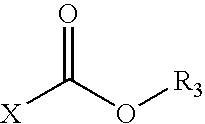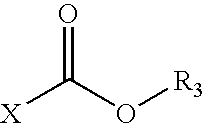Lubricant compositions containing hydroxy carboxylic acid and hydroxy polycarboxylic acid esters
a technology of hydroxy polycarboxylic acid and esters, which is applied in the field of hydrogen fuels, can solve the problems of limiting the service life of the catalytic converter that is used, and achieve the effect of reducing the amount of zinc and phosphates, and not reducing the anti-wear performan
- Summary
- Abstract
- Description
- Claims
- Application Information
AI Technical Summary
Benefits of technology
Problems solved by technology
Method used
Image
Examples
examples
Anti-Wear Four-Ball Testing
[0107]The anti-wear properties of the hydroxy carboxylic acid esters in a fully formulated American Petroleum Institute (API) Group II lubricating oil were determined in the Four-Ball Wear Test under the ASTM D 4172 test conditions. The testing for these examples was done on a Falex Variable Drive Four-Ball Wear Test Machine. Four balls are arranged in an equilateral tetrahedron. The lower three balls are clamped securely in a test cup filled with lubricant and the upper ball is held by a chuck that is motor-driven. The upper ball rotates against the fixed lower balls. Load is applied in an upward direction through a weight / lever arm system. Loading is through a continuously variable pneumatic loading system. Heaters allow operation at elevated oil temperatures. The three stationary steel balls are immersed in 10 milliliters of sample to be tested, and the fourth steel ball is rotated on top of the three stationary balls in “point-to-point contact.” The ma...
examples 1-5
[0110]Triethyl citrate was used as obtained from Aldrich.
example 6
Tripentyl Citrate with Ethyl Dipentyl Citrate
[0111]A 500 mL 3-neck flask, equipped with a subsurface nitrogen inlet, a magnetic stir bar, and a heated Alihn condenser which led to a water cooled short path condenser was charged with 22.92 grams of triethyl citrate, 177.86 grams of 1-pentanol, and 1.51 grams of p-toluenesulfonic acid. The Alihn condenser was heated with fluid from a 90° C. circulating bath. The mixture was stirred at reflux for 24 hours. The reaction mixture was diluted in heptanes, and washed once with dilute sodium hydroxide, then five times with water. Solvent was removed by rotary evaporator. The product contained 83% tripentyl esters and 15% dipentylesters as determined by GC.
PUM
| Property | Measurement | Unit |
|---|---|---|
| wt % | aaaaa | aaaaa |
| wt % | aaaaa | aaaaa |
| wt % | aaaaa | aaaaa |
Abstract
Description
Claims
Application Information
 Login to View More
Login to View More - R&D
- Intellectual Property
- Life Sciences
- Materials
- Tech Scout
- Unparalleled Data Quality
- Higher Quality Content
- 60% Fewer Hallucinations
Browse by: Latest US Patents, China's latest patents, Technical Efficacy Thesaurus, Application Domain, Technology Topic, Popular Technical Reports.
© 2025 PatSnap. All rights reserved.Legal|Privacy policy|Modern Slavery Act Transparency Statement|Sitemap|About US| Contact US: help@patsnap.com



